Jessica Lang Dance performs at Jacob’s Pillow July 5 through 9.
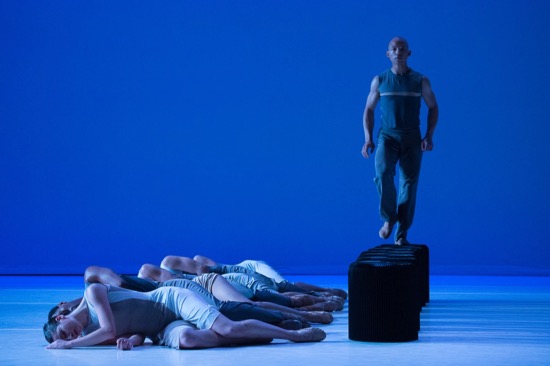
Jammie Walker and members of Jessica Lang Dance in Lang’s Lyric Pieces. Photo: Christopher Duggan
Jessica Lang graduated from the Juilliard School and danced in Twyla Tharp’s company for two years, but performing wasn’t enough for her. However, she didn’t start her choreographic career by founding a company bearing her name. Beginning in 1999, she started making works for ballet companies worldwide —ninety-five to date. She has also choreographed dances for operas and for students in university dance departments. She didn’t launch Jessica Lang Dance until 2011.
The program she has been presenting at Jacob’s Pillow this week marks her company’s fourth visit, and last summer, Pacific Northwest Ballet performed Her Door to the Sky, celebrating the work of Georgia O’Keeffe and the high desert landscapes in which she painted her voluptuous flowers. Although every work shown on the stage of the Ted Shawn Theater is performed by the excellent members of Jessica Lang Dance, not all of the pieces were composed for it. Lang choreographed Lyric Pieces (2013) for England’s Birmingham Royal Ballet. The Calling is a section of a longer piece made for Ailey II in 2006. The Global Dance Theater of Japan commissioned Solo Bach (2008). Of the three remaining works, two—Sweet Silent Thought and Thousand Yard Stare— were created for her company in 2016, and Glow (like Her Door to the Sky co-commissioned by the Jacob’s Pillow Dance Festival) premiered there this past week.
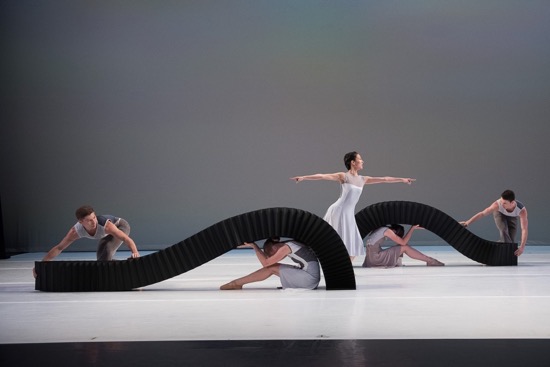
Members of Jessica Lang Dance in Lyric Pieces. Photo: Christopher Duggan
I wouldn’t go so far as to call Lang a chameleon, but consideration of her company’s profile and its dancers makes it difficult to analyze her work as a whole. One thing for sure: she has an architect’s eye—not just in terms of the structures she builds with moving bodies, but through her use of objects and scenic elements. This latter skill is especially prominent in Lyric Pieces, played live by pianist Michael Smith (one of six young Tanglewood Fellows involved). To music by Edvard Grieg, the dancers carry on and off, erect, emerge from behind, crouch beneath, and open and close many black structures (small or wall-sized). Most of these—designed by Stephanie Forsythe and Todd MacAllen— can be fanned open or pleated into portability. Late in the piece, black drum-shaped pieces make an appearance, ready to be sat on or stood on or stacked up.
The effect, as you may imagine, can be entrancing, and some of the choreography’s spirited patterns echo the scenery’s curves and trajectories. However, the movement for various combinations of eight dancers, attractive though it is, offers none of the revelations I’ve come to expect from Lang. A slow, tender duet for Kana Kimura and Thomas Ragland is a high point.
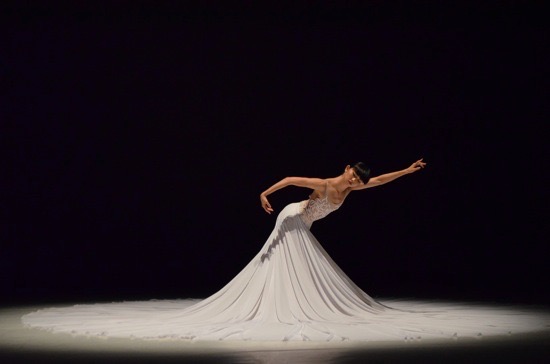
Kana Kimura performing Jessica Lang’s The Calling. Photo: Taylor Crichton
The two solos of the evening were wisely chosen of contrast weighed in. In The Calling, the dancer (Julie Fiorenza the night I attended) stays in one spot almost all the time, while in Solo Bach, Patrick Coker practically never stops bounding around the stage. Fiorenza’s long, long white gown confines her, the immense circle that its hem spreads out along the floor further defined by the lighting (Nicole Pearce after Al Crawford). She seems to hear the same music we do: the Trio Medieval singing the haunting “Oh Maria, Stella Maris.” That could be her, the “star of the sea,” twisting and bending, arching to look behind and above her. When she revolves, the fabric pools closer around her feet; you can imagine her sinking into it.
One of Lang’s missions seems to be the quiet demolition of ballet’s customs in regard to gender. The mix of sexes was malleable in almost every piece, made more so by recasting necessitated by the absence of Milan Misko. In the company’s six Jacob’s Pillow performances, three women danced The Calling four times, and a man (Jammie Walker) appeared in it twice.. Sometimes a male stepped into one of Misko’s roles, sometimes a female.
Only men, however, performed Solo Bach, a buoyantly athletic work set to the “Gavotte en Rondeau” from J.S. Bach’s Partitia No. 3 in E major. The night I attended, the dancer was Coker, and he was marvelous, fluent and easy as he whipped off some surprising steps (a leap that ends in a fall, for instance, with a backflip to rise). He shared the stage with violinist Sarah Atwood, to whom he occasionally greeted in passing. Lang’s choreography juggles contrasts skillfully, and Coker danced the steps not as a virtuosic show-off, but as an ebullient guy having a good time playing with Bach.
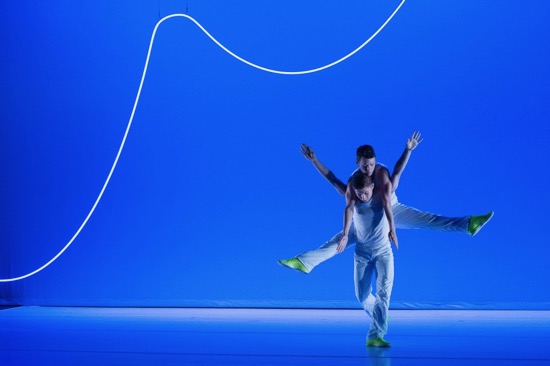
Patrick Coker carries John Harnage in Jessica Lang’s Glow. Photo: Christopher Duggan
Glow is a bright piece in several ways. The fine lighting designer Pearce collaborated with Lang on a neon tube extending on a diagonal that loops from the floor upward; over the course of the piece, it changes from white to yellow to pink. The white garbed dancers (Coker, Kimura, Ragland, Walker, and John Harnage, wear bright-hued sneakers that, in the end, light up. The atmosphere is high-spirited. Kimura is the only woman in the cast I saw, and I’m guessing that the duet with lifts performed by Coker and Harnage might at another performance be executed by a man and a woman. The recorded music sounds light and ringing at times, urgent at others. “2+1” by Ivan Trevino (performed by Bryson Teel and Neal Schassler on marimbas) and “Fractalia” by Owen Clayton Condon (performed by Third Coast Percussion and involving four marimbas plus drums) at times seem to be driving the dance.
Sweet Silent Thought and Thousand Yard Stare are much darker pieces and the first, a quartet, is extremely mysterious. When it begins, we hear what might be a voice speaking through a badly scratched 78 RPM record. Harnage rolls onto Walker. Fiorenza enters, hustles one of them up. Walker briefly supports Harnage. Silvery sidelights beam across a gray background. Kimura enters. I may be in error as to the details, but I’m not, I think, off-base about what the scene portends: lovers craving each other, losing each other, wishing extravagantly for death (or eternal union). They form pairs, clutch themselves as if in deadly pain, reach out, grasp.
The voices that succeed one another on tape aren’t clear most of the time, but the snatches of text sound familiar. “Let not my love by call’d idolatry.” That’s Shakespeare. For a while, I wonder if Lang is conjuring up Othello, what with with the comings together and separations of the four. But no. The words are excerpts from the poet-playwright’s sonnets (30, 64, 40, 105, and 71). What I strive to understand is why Lang made the choice she did. The speakers are actors (and, like Lang, Juilliard graduates), but Nilanjana Bose-Ciupinska, Chukwudi Iwuji, and Chris Myers don’t “perform” the lines; they speak (when you can hear them) quite matter-of-factly, as if reading the sonnets for the first time, or as if they were part of a quiet, one-sided conversation. Perhaps Lang is intimating not just that these words penetrating the crackling sounds are artifacts, but that the dilemmas they speak of are timeless. . .our own.
At one point, just before the end, the women are draped, upside down, as I recall, over Harnage’s back. Then the two men leave, and Kimura stands there looking down at Fiorenza crumpled on the ground. You almost expect her to say, “Alas!” But her silence is even sadder.
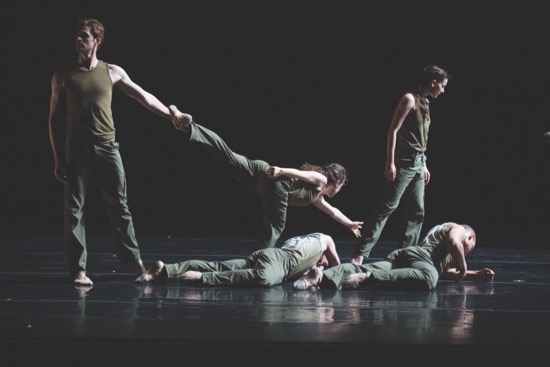
An earlier cast in Jessica Lang’s Thousand Yard Stare. Milan Misko left. Photo: Rosalie O’Connor
Thousand Yard Stare begins in another kind of silence. The title refers to the unfocused stare of a battle-fatigued soldier or to one suffering from post-traumatic stress disorder. Lang interviewed veterans and therapists in preparation for this powerful piece. The nine dancers —those mentioned plus Eve Jacobs, Rachel Secrest, and Claudia McPherson (the company’s rehearsal director replacing Misko)—wear dull green or beige pants and t-shirts designed by Bradon McDonald. Lang deploys the cast in a kind of march that begins in lineups at the sides of the stage. Lunging repeatedly forward and pulling back, freezing momentarily with one bent leg raised to take another step, they take a long time to cover ground. Some face in one direction, others in the opposite one. Now some are in unison, now others. Watching this rhythmic counterpoint is akin to watching a spate of actions dissected and layered together. Then the music starts.
Lang made a brilliant decision in allying herself with Beethoven, setting Thousand Yard Stare to the third movement of the composer’s String Quartet in A minor, No. 15, Op, 132, written in 1825, two years before his death. He had been terribly ill for months, and subtitled the quartet as a hymn of thanksgiving from a convalescent to his God. The music—played by Sarah Atwood, Sarah Peters, Charlotte Malin, and Michael Dahlberg— is labeled “Molto Adagio; Andante.” It hints at both struggle and recovery, and that’s what Lang shows us in her own way: the effort to keep going, to rise from a fall, to support one’s colleagues, to unite with shared purpose.
The dancers form chains, reach out for assistance, crawl over the floor, and fall. They assemble in groups that are almost sculptural; a woman, say, stands almost on the chest of a man braced to support her (perhaps as a lookout), while others link to them or cluster. The expert dancers move crudely, clumsily, or, in their drills, with exactitude. They’re alert to danger, but don’t show us suffering; they do what they need to do. Lang is not out to pull our heartstrings with stories of valor or tragedy. Beethoven’s music cloaking the remorseless patterns, is enough to stir us.
